


This Month in Aviation History
Aircraft of the Month for August 2001
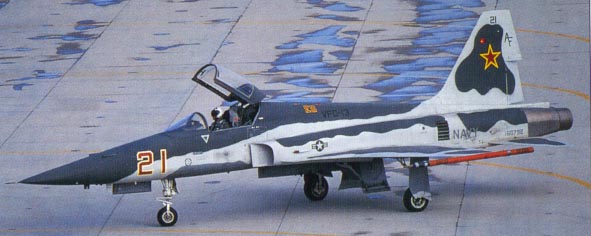





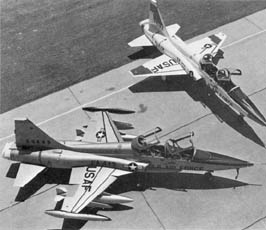 In 1952 Northrop designed the N-102 Fang, its first lightweight jet fighter. The USAF rejected the Fang, which was to be powered by one GE J79 turbojet, but in 1954 the USAF began studying the concept of a lightweight high-performance fighter to supply friendly European and Asian nations through the Military Assistance Program (MAP). Beginning in 1955, Northop began the development a fighter to meet those requirements, which became the N-156. The N-156 was powered by two J85 engines. These were originally developed for decoy drones and as a result were small and had a high power to weight ratio. Due to the need to replace the T-33, the only official USAF interest in the program was at first only for the two-seat N-156T version, which became later the T-38 Talon. Northop continued developing the N-156, and the privately-funded N-156F prototype made its first flight on 30 July 1959, reaching supersonic speeds. The F-5A (model N-156A) was based on the N-156F one-seat variant and was ordered into production in 1962 as the "FX" fighter. At first, export customers did not want to buy an aircraft the United States had not bought, but on 25 April 1962 the Department of Defense chose the F-5 for its MAP. The low purchase price of around $2 million for the F-5A compared favorably with the USAF's new intercepors that cost around $15 million. It was made possible by the aircraft's light weight and simplicity in addition to Northrop's new construction methods such as the NORAIL (Northrop Overhead Rail Assembly and Installation Line), which enabled the assembly line to switch between the T-38, the F-5A, and the F-5B. First flight of a production F-5A was not until 31 July 1963 (flown by Hank Chouteau) due to lack of USAF interest. Service entry, with the 4441st Combat Crew Training School of the USAF's Tactical Air Command at Williams AFB, Arizona, occured in August 1964. At first, the F-5A was used for the Military Assistance Program, complementing the Lockheed F-104. Its low cost and wide tactical capability aided its success. The F-5B (Model N-156B) two-seat version first flew on 24 February 1964. Although its primary role was a trainer and it did not carry the F-5A's two cannon, the F-5B was still fully combat capable and around three hundred were built.
In 1952 Northrop designed the N-102 Fang, its first lightweight jet fighter. The USAF rejected the Fang, which was to be powered by one GE J79 turbojet, but in 1954 the USAF began studying the concept of a lightweight high-performance fighter to supply friendly European and Asian nations through the Military Assistance Program (MAP). Beginning in 1955, Northop began the development a fighter to meet those requirements, which became the N-156. The N-156 was powered by two J85 engines. These were originally developed for decoy drones and as a result were small and had a high power to weight ratio. Due to the need to replace the T-33, the only official USAF interest in the program was at first only for the two-seat N-156T version, which became later the T-38 Talon. Northop continued developing the N-156, and the privately-funded N-156F prototype made its first flight on 30 July 1959, reaching supersonic speeds. The F-5A (model N-156A) was based on the N-156F one-seat variant and was ordered into production in 1962 as the "FX" fighter. At first, export customers did not want to buy an aircraft the United States had not bought, but on 25 April 1962 the Department of Defense chose the F-5 for its MAP. The low purchase price of around $2 million for the F-5A compared favorably with the USAF's new intercepors that cost around $15 million. It was made possible by the aircraft's light weight and simplicity in addition to Northrop's new construction methods such as the NORAIL (Northrop Overhead Rail Assembly and Installation Line), which enabled the assembly line to switch between the T-38, the F-5A, and the F-5B. First flight of a production F-5A was not until 31 July 1963 (flown by Hank Chouteau) due to lack of USAF interest. Service entry, with the 4441st Combat Crew Training School of the USAF's Tactical Air Command at Williams AFB, Arizona, occured in August 1964. At first, the F-5A was used for the Military Assistance Program, complementing the Lockheed F-104. Its low cost and wide tactical capability aided its success. The F-5B (Model N-156B) two-seat version first flew on 24 February 1964. Although its primary role was a trainer and it did not carry the F-5A's two cannon, the F-5B was still fully combat capable and around three hundred were built.
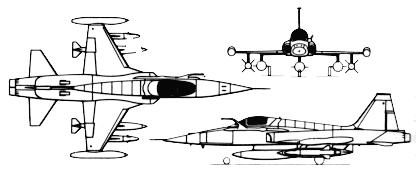
The F-5A/B featured very thin wings with leading-edge slats and trailing-edge flaps. All-moving horizontal tail surfaces were positioned below the turbojets, which were mounted in the rear fuselage and fed by lateral air intakes mounted just behind the cockpit. The fuselage, which was of semimonocoque construction, was "area-ruled" and was made out of aluminum, magnesium, and a small amount of steel and titanium. A brake chute housed in a box beneath the vertical tail supplemented two ventral hydraulically-operated airbrakes. The large number of access doors and hatches made up 25 percent of the fuselages's surface area and allowed for access to the aircraft's serviceable parts. The easily-removable aft fuselage simplified maintenance, and an overhead track and trolley device in each engine bay made engine changes by a ground crew of three possible in twenty minutes.
RF-5A The RF-5A was developed in the 1960s as a tactical reconaissance aircraft. Its nose is modified to hold four KS-92 cameras. Eighty-five were produced, all for export customers (see Exports section).
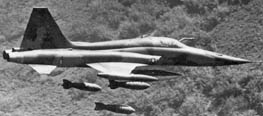 Project Skoshi Tiger
During the Vietnam war a full-scale combat evaluation of the F-5A was completed in the form of the Skoshi Tiger ("little tiger") program, which began in October 1965 when the USAF sent twelve combat-ready F-5As to Vietnam. Involving over 12 aircraft from the 4503rd Tactical Fighter Squadron, based at Da Nang and Bien Hoa, the program featured a high sortie rate: in four months 2,500 flying hours on close support, interception, and reconnaissance missions were clocked up. The F-5 performed extremely well, and experience led to a large number of F-5s being delivered to the South Vietnamese air force.
Project Skoshi Tiger
During the Vietnam war a full-scale combat evaluation of the F-5A was completed in the form of the Skoshi Tiger ("little tiger") program, which began in October 1965 when the USAF sent twelve combat-ready F-5As to Vietnam. Involving over 12 aircraft from the 4503rd Tactical Fighter Squadron, based at Da Nang and Bien Hoa, the program featured a high sortie rate: in four months 2,500 flying hours on close support, interception, and reconnaissance missions were clocked up. The F-5 performed extremely well, and experience led to a large number of F-5s being delivered to the South Vietnamese air force.
Canadian F-5A/B Variants The F-5 was chosen for license-production by Canadair Ltd at Montreal for the Canadian Armed Forces in 1965. Single-seat CF-5As and CF-5D trainers were produced, both which were designated CL-219 by Canadair. Improvements over the standard F-5A/B incldued upgraded navigation, a two-position nosewheel leg, an IFR probe, and more powerful uprated J85-CAN-15 turbojets (license-produced by Orenda Engines of Montreal). The first CF-5A flew on 6 May 1968, and later that year it entered service as the CF-116. Later, another 20 CF-5Ds were ordered for the CAF (Air Element), which brought total CF-5 production to 240. The Royal Netherlands air force (KLu) ordered 105 NF-5As soon after production of the CF-5 began. The NF-5As and two-seat NF-5Bs incorporated automatically scheduled leading-edge maneuvering flaps, 1042-litre (275-US gal) drop tanks, and Doppler radar. Service entry was in 1969 but since then they have been retired. Four CF-5s were built for Venezuela under the VF-5 designation.
The F-5 was chosen for license-production by Canadair Ltd at Montreal for the Canadian Armed Forces in 1965. Single-seat CF-5As and CF-5D trainers were produced, both which were designated CL-219 by Canadair. Improvements over the standard F-5A/B incldued upgraded navigation, a two-position nosewheel leg, an IFR probe, and more powerful uprated J85-CAN-15 turbojets (license-produced by Orenda Engines of Montreal). The first CF-5A flew on 6 May 1968, and later that year it entered service as the CF-116. Later, another 20 CF-5Ds were ordered for the CAF (Air Element), which brought total CF-5 production to 240. The Royal Netherlands air force (KLu) ordered 105 NF-5As soon after production of the CF-5 began. The NF-5As and two-seat NF-5Bs incorporated automatically scheduled leading-edge maneuvering flaps, 1042-litre (275-US gal) drop tanks, and Doppler radar. Service entry was in 1969 but since then they have been retired. Four CF-5s were built for Venezuela under the VF-5 designation.

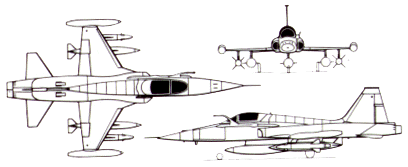
F-5A/B Upgrades Canada, Venezuela, Norway, and other countries have all upgraded their F-5A fleets. Canada's upgrade encompassed an airframe refurbishment, a HUD, advanced avionics and HOTAS controls. All of them have since been retired and offered for sale, 13 of which were bought by Botswana.
F-5C/D The F-5C and F-5D designations apply to forecasted F-5 version for a large USAF order, but that order never came.
F-5E/F Tiger II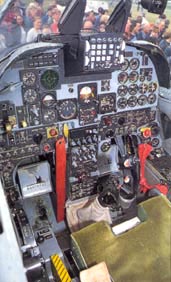 Originally, Northop began working on an improved F-5 as a private venture. The converted F-5A prototype, powered by two General Electric J85-GE-21 turbojets, first flew on 28 March 1969, piloted by General Electric's test pilot John Fritz. This aircraft was submitted to the US Government's International Fighter Aircraft (previously Advanced International Fighter) Competition to replace the F-5A, which was still in full production. On 20 November 1970, the F-5E was officially selected over the Lockheed CL-1200 Lancer (derived from the F-104), the Ling-Temco-Vought V-1000 (derived from the F-8), and a stripped-down version of the McDonnell Douglas F-4, and an order for 325 aircraft followed. The F-5E designation was officially assigned in January 1971, and the first series F-5E made its first flight on 11 August 1972 with Hank Chouteau at the controls.
Originally, Northop began working on an improved F-5 as a private venture. The converted F-5A prototype, powered by two General Electric J85-GE-21 turbojets, first flew on 28 March 1969, piloted by General Electric's test pilot John Fritz. This aircraft was submitted to the US Government's International Fighter Aircraft (previously Advanced International Fighter) Competition to replace the F-5A, which was still in full production. On 20 November 1970, the F-5E was officially selected over the Lockheed CL-1200 Lancer (derived from the F-104), the Ling-Temco-Vought V-1000 (derived from the F-8), and a stripped-down version of the McDonnell Douglas F-4, and an order for 325 aircraft followed. The F-5E designation was officially assigned in January 1971, and the first series F-5E made its first flight on 11 August 1972 with Hank Chouteau at the controls.
Improvements over the F-5A include more powerful engines, permanent wingtip AAM stations, more modern and capable avionics systems, including an integrated fire control system, a two-position extending nosewheel unit, provisions for arrester gear, a widened fuselage, additional fuel, and a larger, modified wing with LERXes and maneuvering flaps. The higher engine power coupled with the new nosegear resulted in 30% better take-off performance. First flight of a production F-5E was on 11 August 1972. The F-5E was more optomized for the air superiority interceptor role rather than the F-5A's tactical fighter role and was envisioned as an answer to the last generation MiG-21s. Deliveries began on 4 April 1973, to the USAF's 425th Tactical Fighter Training Squadron at Chandler AFB, Arizona, where foreign countries buying the F-5E sent their crews to be trained. The F-5E has served as an aggressor at US combat training stations around the world. The 64th and 65th Aggressor Squadrons operate at Nellis AFB in Nevada as part of the 56th Fighter Weapons Wing, and the 527th AS, which flew training missions for NATO, operated at RAF Alconbury in the UK. The 26th AS, based at Clark AB in the Philipenes, carried out training missions for Far Eastern squadrons. A small number of F-5Es were acquired by the USN for its "adversary" DACT mission.
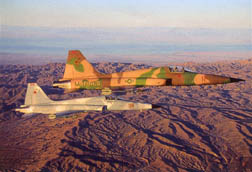
 The F-5F two-seat trainer variant retains full combat capability. The fuselage was lengthened by 1.02 meters (3 feet 4 inches). Development was approved by the USAF in early 1974, and the first flight was on 25 September 1974. In summer 1976, the first of 118 aircraft was delivered. The Brazilian export version incorporates a large dorsal fin to accommodate an ADF antenna. The F-5Fs exported to the Royal Saudi air force featured a Litton LN-33 INS and IFR capability.
F-5E upgrades are offered by several companies including IAI, which upgraded Chili's aircraft with the Elta M-2032 radar, new avionics, HUD, and HOTAS. A staged upgrade program with similar features is offered by Northrop Grumman.
The F-5F two-seat trainer variant retains full combat capability. The fuselage was lengthened by 1.02 meters (3 feet 4 inches). Development was approved by the USAF in early 1974, and the first flight was on 25 September 1974. In summer 1976, the first of 118 aircraft was delivered. The Brazilian export version incorporates a large dorsal fin to accommodate an ADF antenna. The F-5Fs exported to the Royal Saudi air force featured a Litton LN-33 INS and IFR capability.
F-5E upgrades are offered by several companies including IAI, which upgraded Chili's aircraft with the Elta M-2032 radar, new avionics, HUD, and HOTAS. A staged upgrade program with similar features is offered by Northrop Grumman.
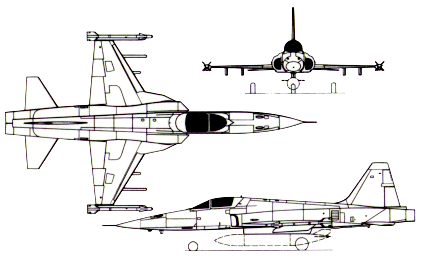
RF-5E Tigereye
On 31 March 1978 production was approved by the US Government for a specialized tactical reconnaissance version. Designated the RF-5E and later receiving the name "Tigereye", it retains full combat capability while carrying reconnaissance equipment in the modified nose. Following its first flight, from Edwards AFB in California, the prototype made its international debut at the 1978 Paris Air Show. Although the new reconnaissance, navigation, and communication equipment add weight to the aircraft, the performance is virtually unaffected. Aside from the additional weight, the RF-5E has basically identical dimensions and characteristcs as the F-5E.
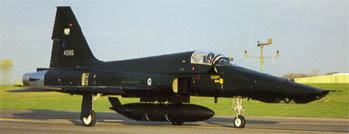
The modified forward fuselage includes a nose extension of 20.3 centimeters (8 inches). A KS-87D1 camera resides in the forward nose compartment, in front of one of three interchangeable pallets: KA-95B and KA-56E panoramic cameras and an RS-701E infra-red linescanner compose Pallet 1; Pallet 2 carries KA-56E and KA-93B6 panoramic cameras, and Pallet 3 is has a KS-147A camera for long-range oblique photography (LOROP) missions. Advanced navigation and communications systems in addition to an Integrated Sensor Control System (ISCS) are fitted to the RF-5E. The first production aircraft, one of the two that made up the first export order (to the Royal Malaysian air force), flew in December 1982, and the RF-5E was exported to Malaysia and Singapore. Six additional Singaporean F-5Es were converted to RF-5Es.

Total Exports
The F-5A was adopted as a Military Assistance Program aircraft to supply freindly Eurpoean and Asian nations due to its wide tactical capability and low cost of purchase and operation. It replaced aircraft such as the F-84, and Northrop ended up producing 879 F-5A/Bs for over a dozen MAP customers. Canada built 250 CF-5A/Ds and NF-5A/Bs (for Holland). The first non-US order order came from the Imperial Iranian Air Force, who ordered thirteen aircraft in 1965, followed by the South Korean Air Force, which received its 20 aircraft from April 1965. Turkey, Greece, Iran, Thailand, South Korea, and South Korea received RF-5A recon versions. The largest export orders for F-5A/B variants came from Norway, Canada (CF-5A/D), Spain (SF-5A/B, 70 built under license by CASA), Holland (NF-5A/B), Iran, Greece, South Korea, Taiwan and Turkey. The F-5E was very popular and received many export orders; over 1,300 F-5E/Fs were built for 20 air forces. License production was undertaken in Taiwan, South Korea, and Switzerland.
Total F-5A/B deliveries totaled 1,197. F-5As and RF-5As were used by the air forces of USA (17), Canada (89), South Korea (87), Ethiopia (13), the Phillipines (19), Formosa (92), Jordan (30), Greece (80), Iran (104), Libia (8), Morocco (18), Norway (94), Holland (75), Pakistan (19), Spain (36), Thailand (18), Turkey (96), Venezuela (16), and South Vietnam (46). The F-5B was used by the air forces of USA (15), Saudi Arabia (20), Brazil (6), Canada (42), South Korea (35), Ethiopia (2), the Philippines (3), Formosa (23), Jordan (4), Greece (9), Iran (23), Libia (2), Malaysia (2), Morocco (4), Norway (14), Holland (30), Spain (34), Thailand (2), Turkey (13), Venezuela (4), and South Vietnam (8).
The F-5E was used by the air forces of USA (79), Saudi Arabia (70), Brazil (36), Chile (15), South Korea (126), Ethiopia (14), Formosa (180), Jordan (44), Greece (141), Kenya (10), Malaysia (14), Swizerland (66), Thailand (13), and South Vietnam. Over 200 F-5Fs were produced for the air forces of USA (3), Saudi Arabia (24), Chile (3), South Korea (9), Ethopia (2), Formosa (18), Jordan (2), Kenya (2), Indonesia (4), Iran (28), Singapore (3), and Swizterland (6).

F-5A of the 341 Mira, Hellenic air force

CF-5A (CF-116) of No.434 (Blue Nose) Sqn

F-5E of the US Navy's Fighter Weapons School

RF-5E of the Royal Saudi Air Force
| Northrop F-5 Specifications | ||||
|---|---|---|---|---|
| F-5A | F-5E | RF-5E | F-20 (F-5G) | |
| Type | Light multirole fighter | Light multirole fighter | Light tactical reconnaissance fighter | Single-seat tactical fighter |
| Powerplant | Two 11.9kN (2690lb) dry and 17.1kN (3850lb) with afterburner J85-GE-5 turbojets (two 19.3kN (4300lb) Orenda (GE) J85-CAN-15 turbojets on CF-5A) | Two 15.5kN (3500lb) dry and 22.4kN (5000lb) with afterburner J85-GE-21B turbojets | Two 15.5kN (3500lb) dry and 22.4kN (5000lb) with afterburner J85-GE-21B turbojets | One 53.3kN (12,000 lb) thrust dry and 80kN (18,000 lb) thrust with afterburner F404-GE-100 turbofan |
| Accommodation | Pilot only | Pilot only | Pilot only | Pilot only |
| Armament | Two internal 20mm M39A2 cannon with 280 rpg; max external load of 1995kg (4400lb), including bombs, rockets, and AIM-9s on four underwing hardpoints, and AIM-9s on wingtip stations. | Two internal 20mm M39A2 cannon with 280 rpg in nose; max external load of 3195kg (7000lb) on two wingtip, one centerline, and four wing hardpoints, including bombs, rockets, guided AGMs (such as AGM-65) and AIM-9s. | One 20-mm M39 cannon with 140 rounds in port nose; up to 3175kg (7000lb) of disposable stores on seven external hardpoints including two wingtip missile rails, including AAMs, ASMs, bonmbs, dispenser weapons, rocket pods, cannon pods, drop tanks, and ECM pods | Two 20-mm M39A2 cannon with 225 rpg in upper forward fuselage; 4080kg (9000 lb) of wepoans on one centerline, four underwing and two wingtip hardpoints; weapons include GPU-5/A 30-mm gun pod, two AIM-7F, six AIM-9s. four AGM-65s, nine Mk 82 227kg (500lb) bombs, or four Paveway LGBs |
| Current Operators | Botswana, Brazil, Greece, Morocco, Norway, Philippines, Saudi Arabia, South Korea, Spain, Thailand, Turkey, Venezuela | Bahrain, Brazil, Chile, Honduras, Indonesia, Iran, Jordan, Kenya, Malaysia, Mexico, Morocco, Saudi Arabia, Singapore, South Korea, Sudan, Switzerland, Taiwan, Thailand, Tunsia, USA, Yemen | Malaysia and Saudi Arabia | None, although Germany, India, Oman, South Korea, and the USN expressed interest. |
| Other Customers | Canada, Ethiopia, Iran, Libya, Netherlands, Taiwan, USA, Vietnam | Egypt | None | None |
| Manufacturers | Northrop (USA), Canadair (Canada), Korean Air (Korea), Fokker (Netherlands), AISA (Spain), AIDC (Taiwan) | Northrop (USA) | Northrop (USA) | |
| Performance | ||||
| Max speed | Mach 1.4 (1488 km/h; 802kt) at 36,000ft; 1046km/h (565kt) at 50,000ft | Mach 1.63 (1730 km/h; 935kt) at 37,000ft | Mach 1.64 (1741 km/h; 940kt) at 36,000 ft | Mach 2.0 (2126 km/h; 1146kt) |
| Max speed at low altitude | Mach 1.1 | Mach 0.95 | No data | Mach 1.2 |
| Cruise speed at 36,000ft | Mach 0.97 (1030 km/h; 556kt) | Mach 0.98 (1040 km/h; 562kt) | No data | Mach 0.95 (1010 km/h; 546kt) |
| Stalling Speed | 237km/h (128kt) | 230km/h (124kt) | No data | No data |
| Max initial rate of climb | 146m/s (28,700 ft/min); 163m/s (32,000ft/min) on CF-5A | 174m/s (34,300 ft/min) | No data | 273m/s (53,800 ft/min) |
| Service Ceiling | 15,400m (50,500 ft); 15,500m (50,850ft) on CF-5 | 15,800m (51,800 ft) | No data | 17,315m (56,800 ft) |
| Combat radius with two 240kg (530lb) bombs and max fuel hi-lo-hi | 990km (485nm) | No data | No data | No data |
| Combat radius with max external bomb load hi-lo-hi | 315km (170nm) | No data | No data | No data |
| Combat radius with two AIM-9s | No data | 1405km (760nm) | 760km (410 nm) hi-lo-hi with one drop tank | No data |
| Combat radius with two AIM-9s, five Mk 82s, and two 1249L (330-US gal) drop tanks | No data | No data | No data | 1019km (576nm) |
| Combat radius hi-hi-hi with internal fuel | No data | No data | 463km (250nm) | No data |
| Ferry range | 2594km (1409nm) | 3720km (2010nm) | No data | 3980km (2165 nm) |
| Takeoff roll | No data | 610m (2000ft) | No data | 450m (1475ft) |
| Weights | ||||
| Empty | 3667 kg (8085 lb); 3700kg (8,157lb) on CF-5 | 4350kg (9558 lb) | 4423kg (9750lb) | 5965kg (13,150 lb) |
| Combat | 5206kg (11,477lb) | 5745kg (12,665lb) | No data | 7265kg (16,015lb) |
| Gross | 6093kg (14,433lb) | 7142kg (15,745lb) | No data | No data |
| Max Fuel | No data | 1980kg (4364kg) | No data | 1980kg (4364kg) |
| MTOW | 9380 kg (20,667 lb); 9249kg (20,390lb) | 11,187kg (24,664 lb) | 11,192kg (24,765lb) | 12,700kg (28,000 lb) |
| Loadings | ||||
| Max thrust | No Data | 0.67-0.79 | No data | 0.97-1.12 |
| Mil thrust | No Data | 0.48-0.57 | No data | 0.65-0.75 |
| Wing (takeoff) | No Data | 390 kg/m² (80 lb/sq ft) | No data | 487 kg/m² (100 lb/sq ft) |
| Wing (combat) | No Data | 332 kg/m² (68 lb/sq ft) | No data | 420 kg/m² (86 lb/sq ft) |
| Dimensions | ||||
| Wingspan | 7.7m (25ft 3in) | No data | 8.13m (26ft 8in) | No data |
| Wingspan over tip tanks | 7.87m (25ft 10in) | Not applicable | Not applicable | Not applicable |
| Wingspan over wingtip AIM-9s | No data | 8.53m (28ft) | No data | 8.53m (28ft) |
| Length | 14.38m (47ft 2in) | 14.45m (47ft 5in) | 14.65m (48 ft 0.75in) | 14.4m (47ft 3in) |
| Height | 4.01m (13ft 2in) | 4.08m (13 ft 5 in) | 4.07m (13ft 4.25in) | 4.2m (13ft 10in) |
| Aspect Ratio | No data | 3.69 | No data | 3.69 |
| Wing area | 15.8m² (170 sq ft) | 17.28m² (186 sq ft) | 17.28m² (186 sq ft) | 18.6m² (200 sq ft) |
| Two-Seat Models | ||
|---|---|---|
| F-5B | F-5F | |
| Type | Operational Trainer | Operational Trainer |
| Powerplant | Two 12kN (2720lb) dry and 18.1kN (4080lb) with afterburner J85-GE-13 turbojets (two 19.3kN (4300lb) Orenda (GE) J85-CAN-15 turbojets on CF-5D) | Two 15.5kN (3500lb) dry and 22.4kN (5000lb) with afterburner J85-GE-21B turbojets |
| Accommodation | Two in tandem | Two in tandem |
| Armament | 2812kg (6200lb) of the same types of weapons carried on the F-5A; no guns | One 20mm cannon; two missiles |
| Fuel Capacity | 2207L (503 US gal) | 2562L (677 US gal) |
| Current Operators | Brazil, Greece, Morocco, Norway, Philippines, Saudi Arabia, South Korea, Spain, Turkey, Venezuela | Chile, Formosa, Indonesia, Iran, Jordan, Kenya, Saudi Arabia, Singapore, South Korea, Switzerland, Thailand, USA |
| Other Customers | USA, Saudi Arabia, Canada, Ethiopia, Formose, Jordan, Iran, Libya, Malaysia, Holland, South Vietnam | Ethiopia |
| Performance | ||
| Max speed | 1434km/h (774kt) at 36,000ft (10,973m) | 1658km/h (895kt) at 36,090ft (11,000m) |
| Cruise speed | 1030km/h (556kt) | No data |
| Stalling Speed | 222km/h (120kt) | 253km/h (136kt) |
| Max initial rate of climb | 154m/s (30,400 ft/min) | 167m/s (32,900 ft/min) |
| Service Ceiling | 15,850m (52,000ft) | 15,484m (50,800ft) |
| Combat range | 570mi (917km) | 518mi (834km) |
| Max range | 2092km (1130nm) | 2353km (1270nm) |
| Weights | ||
| Empty | 3793kg (8361lb) | 4793kg (10,567lb) |
| Gross | 5684kg (12,540lb) | No data |
| MTOW | 9299kg (20,500lb) | 11,407kg (25,147lb) |
| Dimensions | ||
| Wingspan | 7.7m (25ft 3in) | No data |
| Wingspan over tip tanks | 7.87m (25ft 10in) | Not applicable |
| Wingspan over wingtip AIM-9s | No data | 8.53m (28ft) |
| Length | 14.12m (46ft 4in) | 15.64m (51ft 4in) |
| Height | 3.98m (13ft 1in) | 4.01m (13ft 2in) |
| Wing area | 15.8m² (170 sq ft) | 17.28m² (186 sq ft) |
|
1 August 1973 - First flight of the X-24B 2 August 1966 - First flight of the S-22I (Su-7IG) 2 August 1989 - The E-6 enters service 3 August 1954 - Nord Gerfaut becomes the first European aircraft to fly supersonically without afterburner 4 August 1954 - First flight of the P.1A (prototype for Lightning) 4 August 1967 - First flight of the 757-200 4 August 1997 - First flight of the L-159 6 August 1996 - First flight of the XOH-1 7 August 1965 - First flight of the F-4E 7 August 1973 - First flight of the Mirage 2000B 8 August 1967 - First flight of the 737-200 9 August 1956 - First flight of the G.91 prototype 9 August 1963 - First flight of the YRF-4C 9 August 1972 - First flight of the EMB-110 9 August 1976 - First flight of the YC-14 9 August 1996 - First flight of the E-767 with a dummy radome 11 August 1972 - First flight of the F-5E 11 August 1995 - First flight of the ERJ-145 13 August 1962 - First flight of the de Havilland DH.125 14 August 1954 - First flight of the XA4D-1 14 August 1974 - First flight of the first Tornado prototype 18 August 1978 - First flight of the first production PC-7 |
20 August 1969 - First flight of the IA-58 20 August 1947 - The D-558-1 Skystreak establishes a speed record of 640.663 mph 20 August 1992 - First flight of the ALH 21 August 1953 - The D-558-2 becomes the first aircraft to fly above 80,000 ft 21 August 1971 - First flight of the Hawk 21 August 1974 - First flight of the second YF-17 22 August 1950 - First flight of the Venom night fighter 22 August 1963 - The third X-15 reaches an unofficial world altitude record of 354,200 ft 22 August 1974 - First flight of the Shorts 330 engineering prototype 23 August 1954 - First flight of the YC-130 24 August 1932 - Amelia Earhart becomes the first woman to fly across the United States 24 August 1956 - First flight of the production Javelin F(AW).5 25 August 1947 - The D-558-1 Skystreak establishes a speed record of 650.796 mph 26 August 1975 - First flight of the YC-15 27 August 1958 - First flight of the Nanchang CJ-5 27 August 1970 - First flight of the Sikorsky S-67 27 August 1990 - First flight of the YF-23 28 August 1967 - First flight of the U-2R 29 August 1970 - First flight of the DC-10 prototype 29 August 1984 - The second B-1A crashes on its 127th flight, killing its pilot 30 August 1962 - First flight of the YS-11 30 August 1964 - First flight of the Tu-22M-0 31 August 1956 - Rollout of the YB-58
Click here to see a list of links to past Aircraft of the Months, sign or view the guestbook, see the counter, visit my home page, or view the Forum.
|